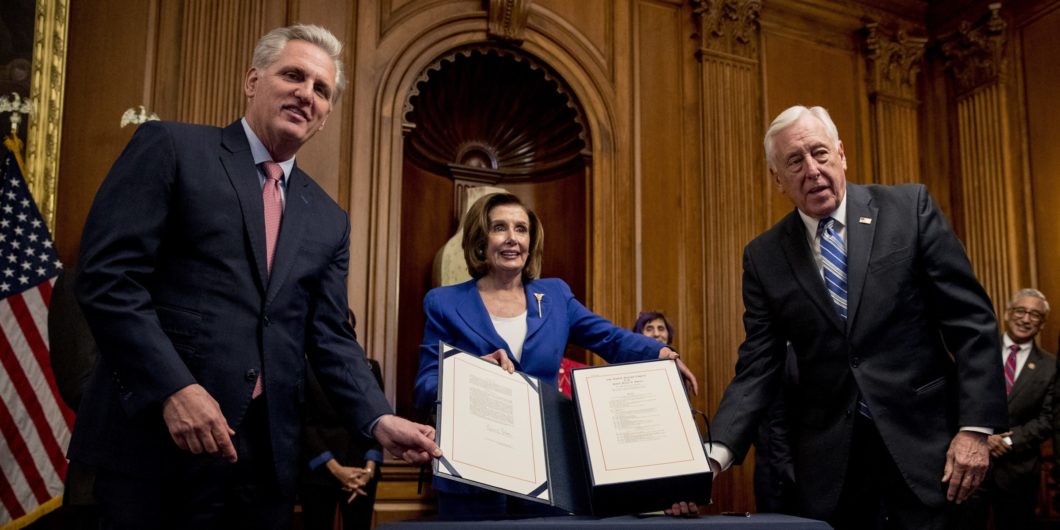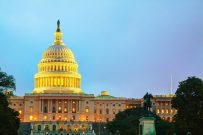Public sector unions are exacerbating our criminal justice crisis and making it much harder to educate the next generation during the coronavirus pandemic.
The Stimulus Bill That Isn't
The unprecedented COVID-19 pandemic is almost enough to make one sympathize with the politicians in Washington, DC and state capitals. And while everybody on social media may think they’ve become an expert on epidemiology overnight, it’s actually hard to know whether government measures are overreactions, too little too late, or the perfect Goldilocks response to the public health crisis. In some ways, it’s also tempting to sympathize with the federal responses to the economic side of the crisis, since this downturn does not fit within any traditional patterns of a recession.
Unfortunately, the Coronavirus Aid, Relief, and Economic Security (CARES) Act, which contains very little economic stimulus, a bit of relief, and a lot of pork, is not likely to provide significant economic relief, and it may even postpone the recovery.
The Economic Problem
The current economic downturn does not fit within traditional economic models. It is not the result of the flagging aggregate demand that Keynesians typically emphasize, nor is it a manifestation of the Austrian business cycle. It is primarily a supply-side crisis, as businesses are forced to shut down.
Unemployment claims at the beginning of April had increased by approximately 10 million. Out of a civilian labor force of approximately 165 million, this represents about six percent. Unemployment will increase dramatically if businesses do not open soon, and the personal hardships will be terrible for those who suddenly find themselves without a paycheck or ready opportunities to switch jobs. But the numbers show a stark dichotomy: the vast majority of American workers are still able to work, and only a minority has suddenly and violently been slammed by unemployment and limited job prospects. This means, in macroeconomic terms, that the vast majority of Americans are suffering not from an unwillingness to spend, but from limited opportunities to do so. It is doubtful that a cash infusion for this majority will lead to more aggregate expenditures. In sum, this is not a crisis of aggregate demand, but a crisis of aggregate supply.
It seems, then, that a federal economic bill in response to the COVID-19 virus would do three things: First, target public health solutions to the crisis, from direct support of hospitals and equipment production, to loosening of regulations that thwart innovation. Second, stimulate aggregate supply by removing barriers to trade and innovation, while urging (or forcing?) the states to do the same. Third, if anything on the welfare front, provide immediate and carefully targeted relief to the small numbers who are suddenly and drastically affected—where the states and civil society need support.
With these criteria in mind, how does the CARES Act address public health, aggregate supply, and welfare?
The CARES Act
The CARES Act was passed by Congress and signed into law by President Trump on March 27, 2020. At $2 trillion, it represents a whopping 50 percent of the 2019 federal budget and about 10 percent of the US GDP. It has been called the largest-ever economic stimulus package—but is it really an economic stimulus package?
The final version is 880 pages long, and different analysts break it down into several different categories. It has proven quite difficult to figure out the details, as it consists of several legislative packages, many categories potentially overlap—and many snouts are in the trough. We can, however, break it down as follows:
| CATEGORY | $BILLIONS |
|---|---|
| Medical/Hospitals | 150 |
| Support to Individuals | 560 |
| Cash to Individuals | 300 |
| Unemployment for Individuals | 260 |
| Support to Small Business | 377 |
| Loans to Small Business | 350 |
| Grants to Small Business | 10 |
| Small Business Loan Relief | 17 |
| Support to Big Business | 500 |
| Airlines/National Security | 46 |
| Loans to Business (And State/Local Gov’t) | 454 |
| Welfare (Mostly Food Security) | 26 |
| Education (Student Loans) | 44 |
| State/Local Government Support | 340 |
| COVID-19 Support | 275 |
| Community Development | 5 |
| Education (K-12) | 13 |
| Education (Higher) | 14 |
| Children | 5 |
| Misc. State/Local | 28 |
Moving from legislative categories to economic classifications, we can break it down differently:
| CATEGORY | $BILLIONS |
|---|---|
| Health/Medical | 425 (21%) |
| Direct | 150 |
| COVID-19 State/Local | 275 |
| Welfare | 635 (32%) |
| Individuals | |
| –Cash to individuals | 300 |
| –Unemployment to individuals | 260 |
| Welfare Programs | |
| –Food security | 26 |
| –Education (student loans) | 44 |
| –Children | 5 |
| Welfare/Pork/Unclear | 937 (47%) |
| Support to Business and Direct Grants | |
| –Loans to small business | 350 |
| –Grants to small business | 10 |
| –Small business loan relief | 17 |
| –Airlines/national security | 46 |
| Miscellaneous | |
| –Community development | 5 |
| –Education (K-12) | 13 |
| -Education (higher) | 14 |
| –Misc. state/local | 28 |
| Loans to Business (And State/Local Gov’t) | 454 |
Looking at our first criterion, $425 billion, or 21 percent of the total, is targeted at fighting the COVID-19 epidemic. If we ignore the details of disbursement, we can assume this category is indeed dedicated to public health.
We run into issues when looking at the second criterion, addressing aggregate supply. From a macroeconomic point of view, the immediate priority after public health should be reducing social isolation and promoting the ability to work, perhaps in a Korean-style, targeted test-and-quarantine approach, rather than blanket social isolation. Aggregate demand is currently strong—or at least potential aggregate demand—with consumers ready and eager to spend as soon as they are able to leave home, and as soon as firms start producing again. So putting money in consumers’ hands will not cause fiscal stimulus. While it may make an immense and immediate difference for a small percentage of recipients, it is unlikely to have any overall fiscal impact, as business closings and social isolation impede spending. What is more, about half of the relief ($300 billion) involves blanket grants to individuals, some of whom are in desperate need, but most of whom are still drawing wages. To be fair, CARES contains some small measures, like a deferral of payroll taxes and other minor but helpful, structural benefits that promote aggregate supply; but these are mostly afterthoughts. In sum, about a third of the CARES Act goes to welfare, but without any appreciable macroeconomic impact.
Even if we assume the best of intentions on the part of politicians, the CARES Act does not address the economy’s real problems.
The third criterion is more complicated. The $377 billion targeted at small business for the purpose of preserving payroll sure looks like welfare—especially because it will support workers in need—but it does not address the lack of production. Likewise, the airline industry is receiving $46 billion—good for its laid-off employees, but not helpful if passengers aren’t flying. The $454 billion in loans to big business and state/local governments is murky and smacks of cronyism, but that is another topic for another time (for example, we’ll let slide $200 million for the arts as a rounding error). None of these target production. The crisis may become one of aggregate demand if aggregate supply is not restored and unemployment continues to rise; but almost 80 percent of the CARES bill currently targets aggregate demand, which is not flagging, without addressing aggregate supply. Thus, it does not address the underlying problem driving the economic downturn.
The package is bad macroeconomics in other ways, too. CARES provides an additional $600/week of unemployment for four months; that’s an extra $15/hour, which is likely to discourage workers from shifting to industries that need surge capacity. If the federal government is to increase welfare, it should do so in a way that does not discourage a return to work. It is now keeping zombie firms afloat without increasing production. It is blindly dumping public money without means-testing, while adding to an already bloated national debt. And it is likely to contribute to inflation, as that debt is monetized by low interest rates. These aspects of the law may actually hinder economic recovery.
An Alternative: Targeting Aggregate Supply
It is intriguing to see a pandemic bill that dedicates only 20 percent of expenditures to public health. It is similarly puzzling to see a macroeconomic bill that dedicates precious little to the underlying economic problem of aggregate supply.
Two alternative approaches would have been much more helpful. First, the federal government could loosen regulations. The FDA could stop impeding the development of new experimental drugs and medical equipment. The federal government could loosen regulations that hamper business growth, including the estimated $1.9 trillion “hidden tax” of complying with federal regulations. It could remove CDC and FDA regulations that thwart the import of masks. Economist Tyler Cowen suggests a number of measures: relaxing federal regulations on licensing requirements for medical professionals (in addition to state requirements), lifting labor restrictions on overtime and weekend work, and reducing (rather than deferring) payroll taxes.
Second, the federal government could use its powers for good by working to roll back state regulations. An estimated 30 percent of Americans require a license (i.e., permission from the state) to earn a peaceful living. In this time of epidemiological-structural unemployment, waiving such licensing would facilitate the shift of labor from industries where telecommuting is impossible into new entrepreneurial ventures (and the health sector). Fully 34 states and the District of Columbia have “price-gouging” laws that thwart the market process, create shortages, and discourage firms from increasing supply or others from entering the field. Some states have rolled back regulations, but 35 still have Certificate of Need restrictions that make it difficult and costly for hospitals to expand their operations. And all the states have byzantine and arcane laws that impede commercial activity, from prohibitions on transportation of alcohol and food on the same trucks, to laws that prohibit home healthcare businesses, laws that prohibit physicians from dispensing medicine without a pharmacy, and laws that ban the dispensation of online advice or require the permission of competitors to open a business.
Some states have lifted some of the sillier restrictions (like Texas allowing food and alcohol to be transported on the same truck, or Michigan allowing a distillery to produce hand sanitizer). But perhaps it is time for the federal government to encourage the states to protect economic liberty—or perhaps to force them to do so under the 14th amendment; the Institute for Justice has been working on this, if on a case-by-case and state-by-state basis.
The CARES Act might be bringing much-needed relief to the small but growing percentage of Americans who can no longer draw a paycheck. But, even if we assume the best of intentions on the part of politicians, and ignore (for a moment) crony capture of the public purse, the CARES Act does not address the economy’s real problems.
Sadly, the CARES Act isn’t really a stimulus bill. It is, rather, good, old-fashioned election-year welfare spending. A terrifying grab at the commanding heights of the economy, it significantly expands an already bloated federal budget with one stroke of the legislative pen, while failing to address the most pressing economic needs.



